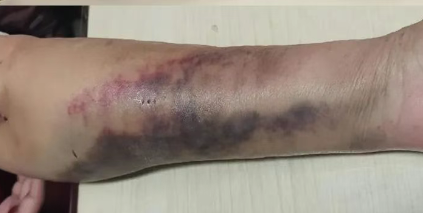After a skin injury, many people notice a bluish-purple swelling around the wound that feels hard and slightly painful. This is a typical subcutaneous hematoma. It's caused by a ruptured blood vessel, leaking blood into the subcutaneous tissue, forming a localized accumulation of blood. While it may look alarming, most cases recover smoothly with proper treatment.

How does a hematoma form?
When the skin is injured by an impact, cut, or surgical trauma, capillaries, or small blood vessels, beneath the skin, rupture. If there's no open wound on the surface of the skin, the blood cannot drain out of the body and accumulates in the subcutaneous tissue, forming a hematoma. Initially, the blood is liquid, but over time, it gradually coagulates and is eventually absorbed by the body. The size of the hematoma depends on the severity of the injury and the extent of the blood vessel damage. It can be as small as a coin or as large as the entire injured area.
In what situations is a hematoma likely to occur?
Certain situations are particularly prone to hematoma formation. For those taking anticoagulants such as warfarin and aspirin, whose blood is less likely to clot, even minor trauma can cause large hematomas. Elderly individuals, whose blood vessels are more fragile, are also more susceptible to this condition. Certain areas, such as the scalp and around the eye sockets, often harbor more pronounced hematomas due to loose tissue. Incomplete hemostasis or premature movement after surgery can also often lead to surgical site hematomas. Furthermore, patients with coagulation disorders can develop large hematomas even after minor collisions.
What are the symptoms of a hematoma?
A typical hematoma has several obvious characteristics. The first is the change in skin color, which gradually changes from the initial red to purple-blue, green-yellow, and finally returns to normal skin color. When touched, you will feel local swelling and hardness, and there will be pain when pressing. If the hematoma is large, it may affect the mobility of adjacent joints. The temperature of the hematoma site may be slightly higher than the surrounding skin, but it is usually not accompanied by obvious fever or other systemic symptoms. It should be noted that if the hematoma area continues to be severely painful, expands rapidly, or shows ischemic symptoms such as skin blanching, it may indicate serious complications.
How to treat a new hematoma?
Proper early treatment is crucial. Immediately after an injury, the RICE principle should be followed: rest and refrain from moving the injured area; apply ice using an ice pack wrapped in a towel for 15-20 minutes, repeated every 1-2 hours, for 24-48 hours; apply pressure using an elastic bandage, but be careful not to tighten it too much to affect circulation; elevate the affected limb to promote blood flow and reduce swelling. These measures can help stop bleeding, reduce swelling, and relieve pain. Remember not to massage or apply heat to a fresh hematoma, as this can dilate blood vessels and exacerbate bleeding.
What should we pay attention to during hematoma absorption?
A hematoma typically takes 2-4 weeks to fully absorb, requiring patient care during this period. After 48 hours, you can switch to a warm compress to promote circulation and accelerate absorption. Appropriate activity can help dissipate the hematoma, but avoid strenuous exercise that may cause further bleeding. Gently massage the area surrounding the hematoma, but avoid direct pressure on the center. If the skin above the hematoma is intact, apply a topical ointment to promote absorption. Maintaining a balanced diet, especially ensuring adequate protein and vitamin C intake, will aid tissue repair.
How to prevent a hematoma?
Prevention is better than a cure, especially for high-risk groups. Those taking anticoagulants should regularly monitor their blood coagulation function and adjust their medication under the guidance of a doctor. Elderly individuals should take precautions against falls and maintain a safe home environment. Exercise protective measures and wear protective gear for vulnerable areas. After surgery, strictly follow your doctor's instructions, exercise appropriate restraints, and avoid premature activity. Maintain a balanced diet and ensure adequate vitamin K intake, which is crucial for blood coagulation function. Keep your blood pressure under control to avoid the increased risk of blood vessel ruptures caused by high blood pressure.
Although subcutaneous hematoma is common, most cases can be cured smoothly with proper treatment and care. For more information on Innomed® Silicone Scar Dressing, refer to the Previous Articles. If you have customized needs, you are welcome to contact us; You Wholeheartedly. At longterm medical, we transform this data by Innovating and Developing Products that Make Life easier for those who need loving care.
Editor: kiki Jia

 English
English عربى
عربى Español
Español русский
русский 中文简体
中文简体








